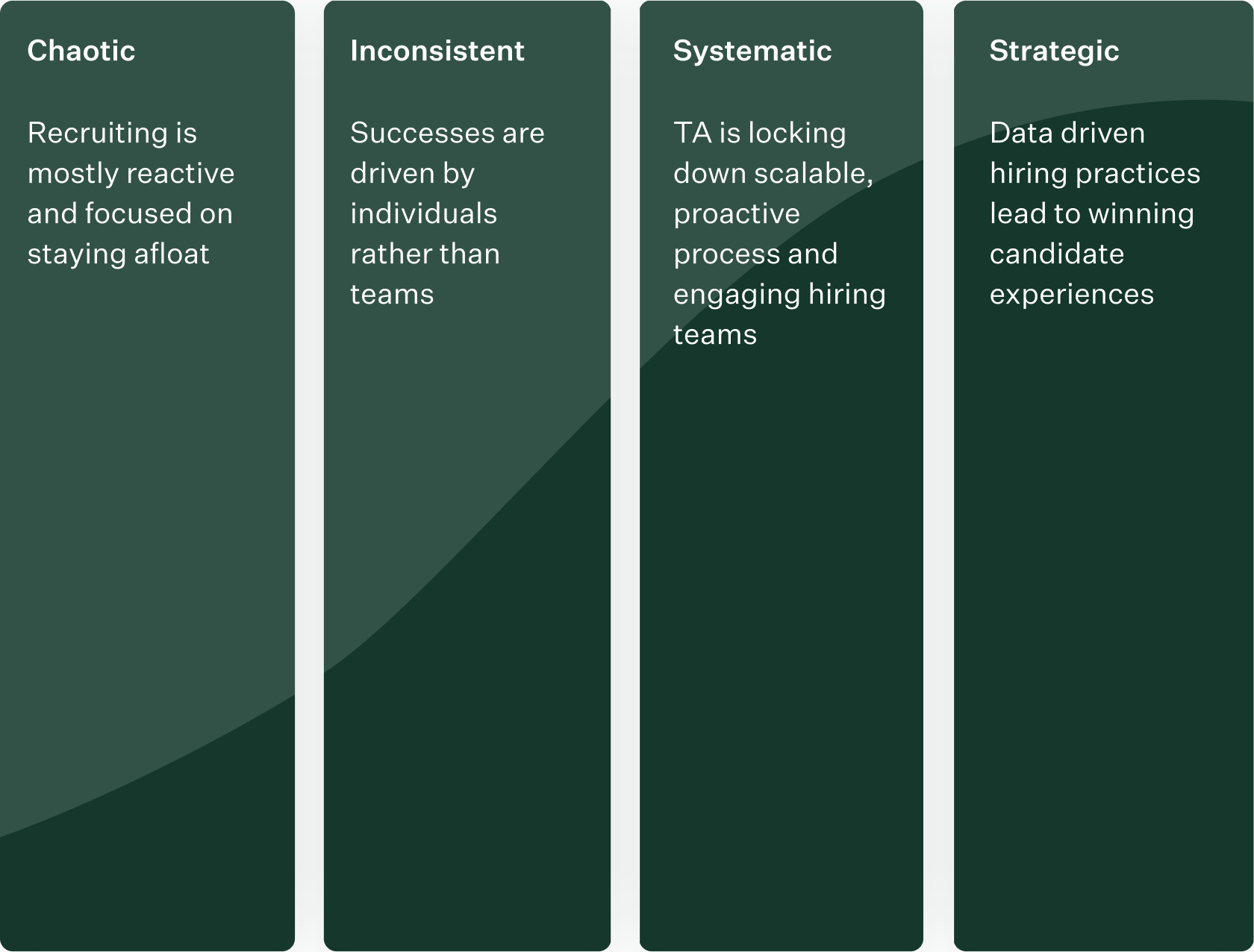
Hiring processes generate a wealth of data along the way – from a candidate’s source to the number of interviews scheduled per week. The companies that excel at hiring know how to maintain quality data and use it to their advantage.
Maintaining quality, reliable data helps keep your team focused on your top-priority jobs and candidates in your day-to-day workflows. You can then look to that data to make more informed, strategic changes to your hiring process.
Making those improvements help you move up the Greenhouse Hiring Maturity™ curve, which we break down into four stages: chaotic, inconsistent, systematic and, finally, strategic. As companies climb the Greenhouse Hiring Maturity curve, we see them start to focus on key behaviors and strategies that help them to fully leverage hiring data to their advantage.

Chaotic and inconsistent stages
At these stages, it’s important to lay the groundwork for effectively measuring, iterating on and improving your hiring process. Start out by seeking clarity on your workflows and what data you’d like to report on – this is the foundation of designing a structured, consistent hiring process. Follow up with building consistent workflow practices and getting familiar with key reports that align to those priorities.
Key actions for enabling change management:
- Document all key processes – how a role gets opened, how a hiring manager gets updated on progress and how a role gets closed
- Learn about the many benefits of a hiring process map with this insightful customer example
- Establish your KPIs to help share your recruiting team’s progress with key stakeholders and the whole organization
- Start with typical recruiting KPIs such as offer acceptance rate, candidate satisfaction and time to hire
- Review key metrics, such as pipeline and candidate volume stats, on a regular cadence to to inform your operational decisions
- Consider these 5 KPIs for operational excellence
- Watch our webinar to learn how to get started with essential reports
Follow this up with further action:
Kick-start insights on your hiring process: Learn about and run essential reports
Familiarize yourself with more reporting tools and how to run custom reports
Check out our customer education page for the latest training and events on reporting
Additional configurations to make in Greenhouse with your team
- Add offices and departments to each job on the “job info” page
- Make candidate source required in Permission policies to ensure every candidate has a source
- Audit default rejection reasons and add custom ones
Systematic stage
At this stage, your data is trending toward consistency and accuracy – also known as “data integrity” – which means you can begin drawing valuable insights from your hiring data. The quality of your reporting depends on the accuracy of your data. So as you work to become more strategic, take control of your Greenhouse Recruiting account’s data integrity. Become more specific about how you’ll measure your hiring team’s performance and evaluate your headcount/capacity planning.
Key actions for enabling change management:
- Align everyone using your Greenhouse Recruiting account on the best practices to ensure data integrity
- Make maintaining clean data a competency for performance reviews
- Check out our webinar to learn more about the value of clean data
Take action in Greenhouse with the following configuration:
Clean up reporting data by adopting consistent stage naming conventions
Gain insight into offer acceptance by resolving every offer (accepted/declined)
Secure data integrity by auditing permissions so that users have appropriate access
Check out our customer education page for the latest training and events on reporting
- Leverage data to help align your recruiters on what strong performance looks like
- Consider including such metrics as sourcing goals, as well as expectations around volume of hiring
- Define what constitutes a full workload for a recruiter at your organization – read our blog post to see how we do this at Greenhouse
- Create a planning model for your organization that allows you to better anticipate hiring needs and plan for the year rather than constantly fielding one-off headcount asks
- Check out this blog post for ideas and considerations to help you plan
Additional configurations to make in Greenhouse with your team
- Automate running and sending key reports
- Explore integrations with other data tools you're using
- Explore advanced reporting tools like report builder to create custom reports for your organization (available for customers on our Advanced and Expert tiers) – Webinar and Support article
Strategic stage
At this stage, you have granular insight into each dimension of hiring. You can consistently identify which parts of your hiring process are effective and those that need improvement. Here are some practical tips to help you truly become a leader in the space – and stay there.
Key actions for enabling change management:
- Recruiting operations can level-up your reporting abilities and help you continue to build a more predictable hiring process
- Read our blog to learn more about the role and value of recruiting operations
- Maintain a consistent schedule for reflection and process iteration to ensure you are constantly moving the needle and improving
- Gather key stakeholders involved in the hiring process to discuss what’s going well, what’s just okay, and where you should focus your efforts
- Identify action items and next steps for refinement
- Learn more about planning and leading a process retrospective with the help of our blog post
- Start reporting on the quality of your new hires based on actual performance in the role – consider circling back on the initial scorecard after 90 days in the role
- Assess the overall employee lifetime value, including how fast your onboarding team is able to ramp new hires, to help measure the quality of your hires
- Check out this blog post to help determine the ROI of a quality hire and read this eBook to better understand the value of investing in your people
Additional configurations to make in Greenhouse with your team
- Complete your first data quality audit; schedule these to run on a regular cadence
- Gain insights into your forecasting ability and performance by entering target start date for open jobs – edit an opening on a job with one-stage approval and edit an opening on a job with two-stage approval
- Explore rich insights by connecting Greenhouse to your Business Intelligence Tool (available for customers on our Expert tier)
- Check out our customer education page for the latest training and events on reporting